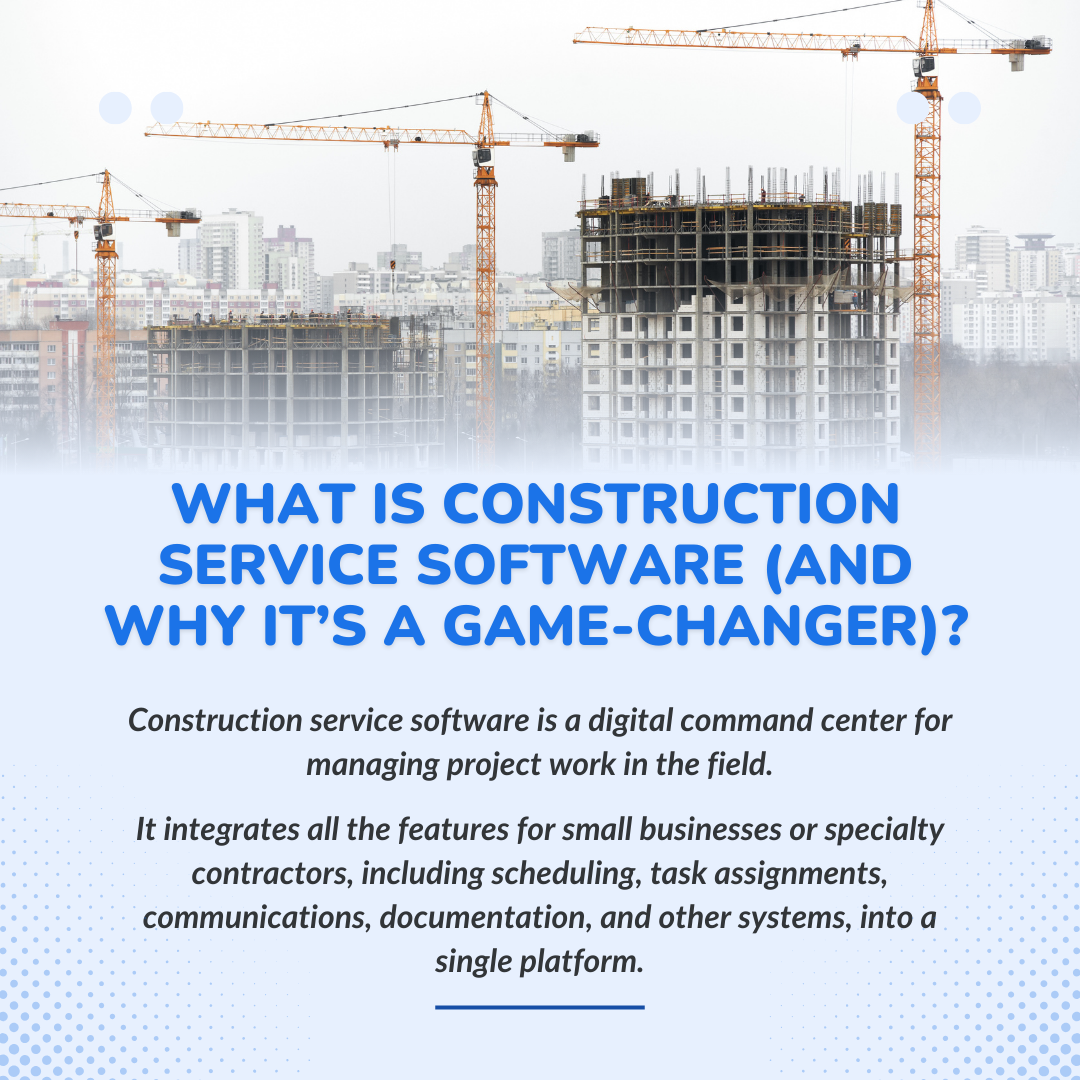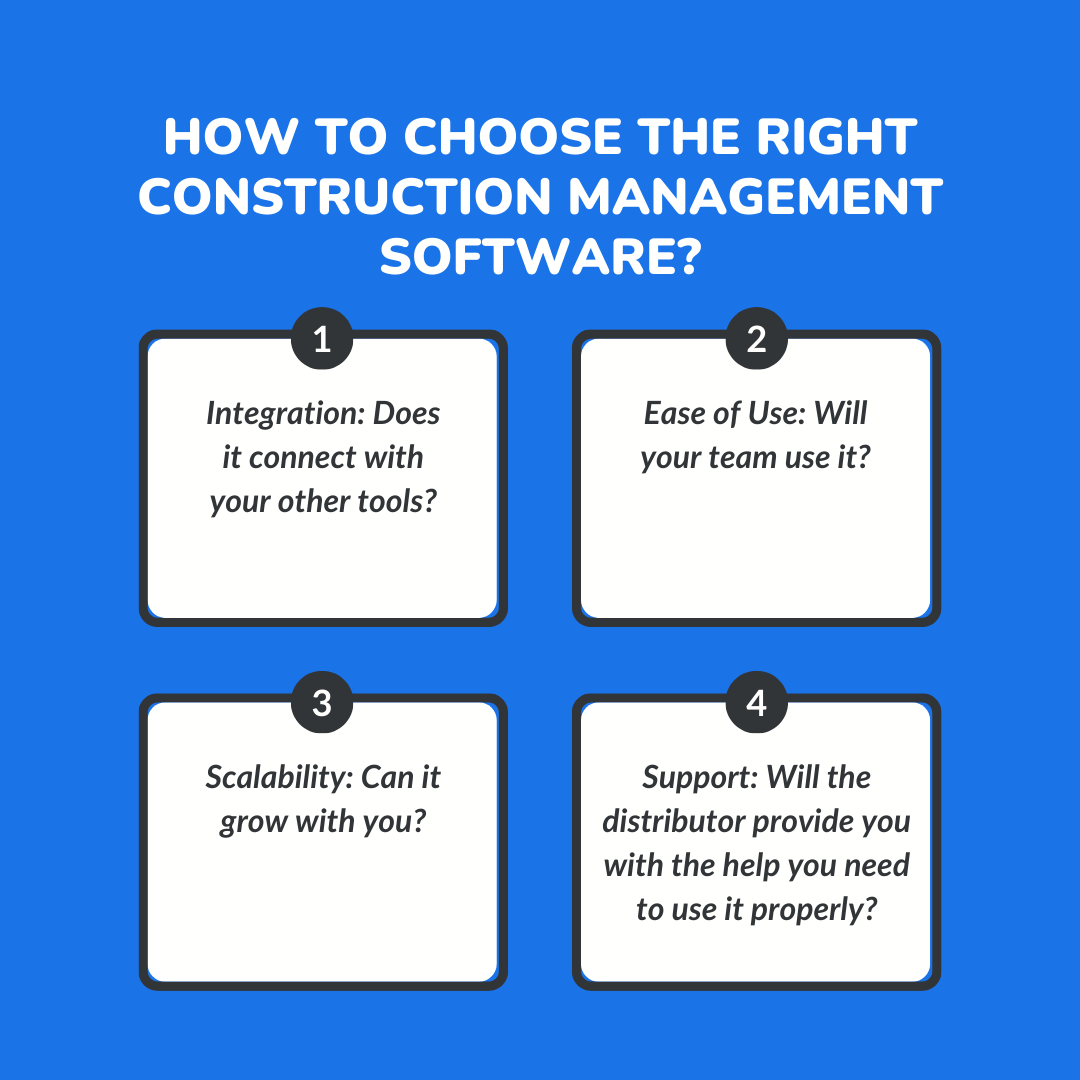A remodeler is juggling two active projects. The crew waits for instructions while a client calls with a change in materials.
Even with the best construction solutions available, using multiple systems can create overlap, confusion, and delays.
But an all-in-one approach cuts through the complexity, keeping every team, task, and timeline perfectly aligned in the construction process.
Best Field Service Tools for Remodelers & Small Construction Teams
Every minute spent without a clear direction drives up costs. Extra labor hours pile up, and client trust takes a hit.
The right construction service software, combined with a streamlined field tech stack, helps close this profit gap.
This guide offers a curated shortlist of tools designed to enhance field team coordination, improve jobsite communication, and manage change orders efficiently.
Key Takeaways:
- Remodelers and small builders can take control over budgets, schedules, and their client communication using one connected platform.
- Managing tasks, change orders, and documents in the same place ultimately mitigates delays and avoidable rework.
- Platforms like ConstructionBase convert scattered workflows into a streamlined and predictable way of working that protects your margins and increases project capacity.
Core Challenges Remodelers Face Every Day
1. Misaligned Communication
Field instructions shift during the day. Without a central channel, details of project progress slip away. Contractor foreman waits for updates while project teams chase confirmation. Therefore, each delay increases the schedule risk due to poor collaboration tools.
2. Multi-Site Oversight
Remodelers frequently manage crews and contractors across multiple neighborhoods in a single day. Tracking each team’s status through texts, calls, and spreadsheets pulls focus away from making confident decisions.
3. Disruptive Change Orders
Material changes, design tweaks, or unforeseen structural issues can occur mid-project. Without immediate capture and approval, these changes lead to rework, extended timelines, and errors in job costing or daily logs.
4. Client Update Bottlenecks
Clients expect timely updates tailored to their project lifecycle. Endless calls and scattered emails slow both field and office teams, creating repetitive delays at each project milestone.
5. Poor Document Management
Plans, permits, and progress photos are often scattered across email threads, personal devices, and printed binders. This fragmentation increases the risk of outdated files guiding work, causing mistakes and inefficiencies.
Solution: A Construction Software
- A single project management platform aligns teams, jobsites, and clients.
- Schedules update in real time.
- Change orders receive instant approval with great document management tools.
The result: faster decisions, better access to information, and more predictable project outcomes.
What is Construction Service Software (and Why It’s a Game-Changer)?

Construction service software is a digital command center for managing project work in the field.
It integrates all the features for small businesses or specialty contractors, including scheduling, task assignments, communications, documentation, and other systems, into a single platform.
The construction software market is expected to expand from USD 10.76 billion in 2025 to USD 21.04 billion by 2032, at a CAGR of 10.1% during the forecast period.
Remodelers and small builders rely on it to keep their crews, clients, and project details organized without using multiple apps or manual tracking.
Core Functions General Contractors Want:
- Scheduling & Task Management: Assign work to crew members, change timelines, and monitor task completion in real time.
- Communication Hub: Organize all messages, files, and instructions inside a single conversation accessible to the entire team.
- Change Order Tracking: Capture any changes in real time, approve them in one click, and keep your schedule updated without stopping work.
- Document & Plan Management: Store plans, permits, contracts, and progress photos in a single location, ensuring everyone uses the latest version.
- Resource & Equipment Management: Track labor, tools, and materials across multiple sites to optimize usage and reduce waste.
- Reporting & Analytics: Monitor project progress, labor hours, costs, and performance trends through dashboards that support data-driven decisions.
- Client Collaboration & Updates: Share progress updates, approvals, and reports directly with clients to keep them informed and reduce unnecessary calls or emails.
The Pendulum is Swinging toward Digital Construction Management Software
Adoption of dedicated field-oriented construction software has increased dramatically in recent years.
This demonstrates that builders who use dedicated software for project management deliver jobs faster with fewer over-budget jobs.
For crews of 1–5, working smarter and faster translates to higher client satisfaction, smoother operations, and stronger business growth.
Why Remodelers and Small Builders Need a Unified Tech Stack?
Remodelers and small builders often manage multiple sites simultaneously with limited staff.
Each project comes with custom client requests that can evolve quickly, and scope changes can occur mid-project.
Without a centralized system, margins and schedules are harder to track, increasing the risk of inefficiency and delays.
What Happens Without a Right System?
Without proper construction software:
- Change orders and updates may go unrecorded.
- Field worker progress is not tracked accurately.
- Project updates are missed, leading to miscommunication.
- Client satisfaction drops, and profits can suffer.
A unified tech stack keeps every moving part aligned, ensuring projects stay on time, on budget, and on track.
Top Reasons Builders Rely on Digital Solutions (Source):
| Benefit Addressed by Construction Software | % of Firms Reporting |
|---|---|
| Maintaining safe job sites | 51.4% |
| Meeting compressed delivery schedules | 44.3% |
| Maximizing field productivity | 40.5% |
| Data-driven insights | 40.2% |
Field Service Solutions That Keep Jobs on Track
A. Mobile-Friendly Job Management Software
When clients schedule jobs via phone, mobile access saves time otherwise spent searching manually.
Crew can also access the orders on mobile. No delay in project completion.
Result: Jobs stay on schedule, and efficiency improves across every site.
B. Jobsite Communication Platforms
Clear updates prevent mistakes before they happen. Real-time messaging, photo and video sharing, and searchable history ensure every instruction is visible. A quick voice note replaces a five-minute call.
Result: No confusion, missed instructions, or repeated work.
C. Change Order Management Tools
Change orders are a natural part of remodeling, but delays in capturing or approving them can disrupt schedules and inflate costs. Modern tools allow you to create, approve, and track change orders in real time.
Digital signatures and automated pricing ensure that approvals happen instantly, while estimates feed directly into project billing. Everything stays accurate, auditable, and integrated with the project workflow.
Result: Every change is approved, priced, and paid for before the work begins.
D. Document & Drawing Access Tools
Outdated plans and misplaced files can derail a project and eat into profits. Cloud storage with permissions ensures only the right people have access to the right files.
Version tracking keeps yesterday’s drawing from sneaking back into circulation, and offline access keeps crews working even without a signal.
Result: Crews work with the latest specs every time.
E. Site Progress Tracking & Bid Management Software
Daily logs, time-lapse tracking, and photos provide complete jobsite visibility without constant supervision.
On the other hand, Bid management software helps to keep a check on proposals and track client updates. It keeps the owner informed and ready to sign the next check.
Result: Progress stays visible, payments move faster, and trust builds without extra calls.
F. Equipment & Inventory Management Tools
Remodelers can track tools, materials, and supplies across multiple sites in real time. The tools also alert for low stock, preventing delays, and usage history helps plan future projects.
Result: No downtime due to missing tools or materials.
G. Field Reporting & Analytics Tools
If you are still chasing handwritten logs or compiling spreadsheets at the end of the week, it's time to upgrade.
Modern field reporting tools automatically capture crew performance, track project timelines, and monitor costs in real time.
Built-in analytics highlight bottlenecks, flag delays, and surface opportunities to improve efficiency across jobs.
Result: Managers gain actionable insights without the legwork, empowering them to make data-driven decisions.
H. Safety & Compliance Management Tools
Digital tools let you log inspections, safety checks, and compliance reports instantly.
Automated reminders for certifications, equipment checks, and regulatory deadlines keep your team proactive rather than reactive.
Result: Risks are minimized, compliance is maintained, benefitting both crews and clients.
Top Field Service Tools for Remodelers & Small Construction Teams

In remodeling, time is always working against you. Schedules shift. Crews get stuck waiting for approvals. Clients call asking for the “latest update” when you’re knee-deep in another site.
The right field service tool cuts through all of that. Below is a list of some of the top field service software used widely.
1. ConstructionBase
Best for: Remodelers and small builders seeking a centralized platform to streamline business operations, eliminating the need to manage multiple apps.
Why remodelers like it:
ConstructionBase is built for the pace of small construction teams. Instead of separate apps for scheduling, chat, change orders, and drawings, it folds them all into one dashboard.
Schedules update in real time. Crews check in with GPS so you instantly know who’s on-site without chasing calls, and change orders get approved on the spot, no more waiting days for signatures.
Features:
- Easy Scheduling: Drag-and-drop scheduling boards make assigning tasks simple and fast. Updates appear instantly for every crew member, eliminating confusion and delays.
- GPS-Based Check-Ins: Track who’s on-site without calling around. Crew check-ins are logged automatically with GPS, so you know where resources are in real time.
- Integrated Communication Hub: You can keep all chats, file sharing, and voice notes tied to the correct project. No more scattered messages or lost instructions.
- Digital Change Order Approvals: Capture change requests on-site, get instant digital signatures, and automatically update project costs and timelines without halting work.
- Version-Controlled Drawings & Documents: Store all drawings, specs, and permits in a central hub with version tracking. Everyone always works from the most recent file.
- Budget & Cost Tracking: Track project costs against estimates to spot overruns early and keep jobs profitable.
- Automated Photo Logs & Reports: Field teams upload daily photos that feed directly into client-facing progress reports, saving hours of status update emails.
Remodeler takeaway: If you hate “app hopping” and want everything connected, this tool is the fastest way to simplify your operations without losing control.
2. Procore
Best for: Large growing contractors who need significant oversight.
Why remodelers like it :
Procore’s depth is unmatched; you can run massive multi-phase projects with strict documentation. Every RFI, submittal, and punch list lives in one central hub.
But with that depth comes complexity. Smaller crews can find it overbuilt for day-to-day use, and the learning curve is steep if you don’t have dedicated admin staff.
It Offers:
- Bid Management: Manage bids, compare subcontractor proposals, and streamline tendering.
- BIM (Building Information Modeling): View, navigate, and collaborate on 3D models directly in the field.
- Estimating: Create accurate takeoffs and cost estimates quickly to win more work.
- Project Management: Central hub for RFIs, submittals, drawings, schedules, and daily logs to keep jobs on track.
- Accounting Integrations: Sync financial data with existing ERP/accounting systems to avoid double entry.
- Analytics and Assist: Gain real-time insights through customizable dashboards and use AI-powered automation to handle routine tasks and boost team productivity.
- Resource Tracking: Monitor labor allocation, crew attendance, and productivity across multiple jobs to maximize efficiency and reduce downtime.
Remodeler takeaway: A heavyweight platform for heavyweight projects. If you’re not running multiple large jobs at once, it can be more tool than you need.
3. Buildertrend
Best for: Small businesses seeking an operational cloud-based software with client-facing features.
Why remodelers like it:
Buildertrend is one of the few solutions that combines project tracking with client portals. You can easily send updates, upload photos, and manage budgets in one application.
Buildertrend is particularly effective for teams that want to keep customers informed without annoying phone calls and frustration.
Features:
- Project Planning & Pre-Construction: Plan, design, and prepare for projects with tools for estimates, takeoffs, bids, scheduling, selections, and pre-construction workflows.
- Project & Construction Management: Track and manage projects through every stage with features like job costing budgets, change orders, client updates, sub portal access, and smooth completion and handoff processes.
- Sales & Communication Management: Attract and capture leads, track them from inquiry to contract, and keep teams, clients, and subcontractors connected throughout the project.
- Financial Management: With this tool, you can improve cash flow and profitability with job costing, budgeting, bills, purchase orders, and invoice management.
- Materials & Warranty Management: Streamline procurement with access to top brands, supplier discounts, cashback rewards, and efficiently manage warranties post-completion.
Remodeler takeaway: Covers most bases relatively well. If you require more specific tracking in the field, you may need to use a different tool as well.
4. CoConstruct
Best for: Custom home builders and remodelers with high client involvement in design and selections.
Why remodelers like it:
CoConstruct offers a comprehensive feature set that integrates design selection, budget, and schedule, making it an ideal option for clients involved in selecting finishes, materials, and layouts.
It also consolidates all your client communications in one place, so you don't have to dig through emails to find a single "Can we change that tile?" question.
Standout strengths:
- Single-Entry Estimating: Enter your cost data once, and CoConstruct lets that flow automatically from estimate to specs, selections, proposals, change orders & and purchase orders, with full QuickBooks integration.
- Scheduling & Project Planning Tools: Create, adjust, and manage project timelines with schedule templates, Gantt & calendar views, drag-and-drop editing, critical path highlighting, and real-time schedule notifications for teams and subs.
- Jobsite Tracking & Daily Logs: Field teams can log daily activities, weather, delays, and issues via mobile; upload photos, share and annotate them; and generate summary jobsite status reports.
- Selections Management: Clients can make product/material selections via templates, see pricing in real time, get reminders for decision deadlines, sign off on selections, and trigger purchase orders or change orders seamlessly from those selections.
- Bidding, Proposal, Lead Management: Generate proposals easily using templates; build, send, and compare bid requests; track leads from inquiry through contract; allow clients to see pricing and make changes.
- Financials: Budgeting, Cost Tracking, Invoicing, Profitability: Track your project budget vs actuals, manage expenses, push financial data to QuickBooks, show client billing & payments, forecast profits, and gain full visibility into costs and revenue.
- Client & Team Communication + Client Portal: Centralized messaging, shared files/photos, client-facing portals showing project updates, progress logs, and pricing transparency.
Remodeler takeaway: Ideal for workflows that heavily rely on design collaboration. Less focused on live field tracking than tools built with crews in mind.
5. Fieldwire
Best for: Field-first teams that want crystal-clear daily priorities and up-to-date plans.
Why remodelers like it:
When teams need to be crystal clear on their action items for the day, where they're completing tasks, and which plan they're referring to, Fieldwire makes it easy.
Tasks can be assigned dates and times, drawings can be marked up immediately, and all updates are synced to other devices. It can even be used offline for jobsites with limited connectivity.
Standout strengths:
- Field Management: Create, assign, and track tasks, punch lists, inspections, and schedules to keep the field team organized and on time.
- Project Management: Manage RFIs, submittals, change orders, budgets, documents, and project specifications to ensure smooth execution and accurate records.
- Plans and BIM: View, annotate, and interact with construction plans, as-built drawings, and BIM models directly from any device.
- Reporting: Generate customized reports and digital forms for inspections, timesheets, and daily project updates to monitor progress efficiently.
- App Integrations: Connect Fieldwire with other software tools to streamline workflows, data sharing, and overall project management.
Remodeler takeaway: A jobsite clarity machine. If you also need built-in client updates or billing features, you’ll be pairing it with something else.
6. Houzz Pro
Best for: Remodelers who market heavily and want leads flowing in from day one.
Why remodelers like it:
Houzz Pro blends marketing and client communication. You can attract new leads directly from the Houzz platform, then move them into project boards, proposals, and payment tracking.
Standout strengths:
- 3D Floor Plans: Create interactive, photorealistic floor plans to visualize designs and win client approval.
- Client Dashboard: Provide clients with 24/7 access to project updates, enhancing transparency.
- Estimates & Proposals: Generate branded documents in minutes to impress prospects.
- Invoices & Online Payments: Request upfront deposits and accept credit cards and bank transfers for faster payments.
- Mobile App: Manage projects on the go with the Houzz Pro mobile application.
- Google Suite Integration: Streamline project and file management by pulling files directly from Google Drive.
Remodeler takeaway: Great for building your pipeline.
How to Choose the Right Construction Management Software?

Purchasing the wrong software can sometimes be like buying a shiny new tool that sits in the truck because no one knows how to use it.
The right one, though, becomes as essential as your tape measure, and you’ll wonder how you worked without it.
Here’s how to stack the odds in your favor:
1. Integration: Does it connect with your other tools?
If you already use accounting software, an estimating app, or a CRM for leads, your construction software should work seamlessly with them.
Otherwise, you’ll be stuck entering the same data twice, and nothing slows a project manager down faster than doing duplicate work.
2. Ease of Use: Will your team use it?
Your supervisor might be happy with a dashboard that is filled with tabs, but your field crew probably won’t be.
So, look for a tool you can teach to a field worker in minutes, yet still gives your office staff the ability to run reports and track budgets, all without spinning up another spreadsheet.
3. Scalability: Can it grow with you?
So, currently you are a team of 5, but what if you get a few big contracts and double your staff in a year? Will the system still work for you?
Therefore, choose a platform that lets you add users, manage more projects, and handle bigger budgets without forcing you to start over.
4. Support: Will you get the help you need to use it properly?
When something breaks or a new member needs training, you want a distributor who will answer the phone or hop on a quick call.
Good onboarding puts you in a good position to succeed, while reliable ongoing support keeps everything running smoothly and prevents you from losing hours of productivity when issues arise.
Read:5 Signs Your Construction Company Needs Project Management Software
Fast Wins You’ll See After Upgrading Your Field Tech
When you bring the right tech into the field, the payoff shows up fast. You don’t have to wait months to see a return; some changes kick in by the very next project.
1. Approvals go from days to minutes
With mobile change order tools, send the update right away, get a digital signature, and change the budget before the crew even leaves the location!
You no longer need to wait for paperwork to crawl through the office, and workers won't have to spend time standing idle while decisions drag through email.
2. Outdated instructions stop costing you
Crews no longer have to guess from last week’s drawings or unclear texts. Updated plans live in their pocket, complete with version control that ensures everyone sees the same specs.
The result: less rework, fewer wasted materials, and fewer billable hours lost to confusion.
3. Clients stay in the loop without chasing you
Instead of taking "what's the status?" calls, clients get real-time updates pushed directly to their phones-progress photos, logs, and completion notes they can check anytime.
This transparency builds trust, keeps conversations positive, and positions you as a reliable partner.
4. Timelines tighten and capacity grows
Fewer delays, fewer mistakes, and smoother client communication all stack up to faster project completion.
And when jobs finish faster, you can take on more work in the same year without burning out your team.
Meet ConstructionBase: One Platform That Covers It All

Most remodelers are familiar with the frustration of managing five different apps for five other jobs.
You have separate tools for scheduling, chat, drawings, and change orders. Half your time is spent jumping between them, not running the project.
ConstructionBase was built to fix that. It’s designed specifically for remodelers and small builders who want to run every job from a single dashboard, from the
first schedule to the final payment, with the specific needs of general contractors.
Core features of ConstructionBase include:
1. Project Management
Keep every detail organized in one place. Schedule tasks, assign responsibilities, and track progress in real time to ensure projects stay on course from start to finish.
2. CRM (Client Relationship Management)
Build stronger client relationships. Track every lead, follow up on opportunities, and manage your sales pipeline all from a centralized hub designed for contractors.
3. Takeoffs
Speed up planning with accurate digital takeoffs. Pull measurements directly from blueprints and combine them with live market data to estimate materials and costs instantly.
4. Bidding
Win more jobs with less effort. Generate professional bid proposals, send them out in minutes, and compare subcontractor offers side by side to choose the best fit.
5. Scheduling
Use drag-and-drop timelines to plan tasks, adjust schedules on the fly, and keep your crews aligned—without endless back-and-forth calls.
6. Estimating
Create precise cost estimates quickly. Combine digital blueprints with live pricing data to deliver accurate budgets and protect your profit margins.
7. Document Management
Put all project files at your team’s fingertips. Store and organize drawings, specs, and contracts securely in the cloud so everyone works from the same up-to-date documents.
8. Inventory Management
Stay on top of materials by tracking stock levels, setting up automated reorder points, and avoiding costly delays from missing supplies.
9. Finance Management
Manage job costing, payroll, expenses, and cash flow in one place to keep your business profitable and predictable.
The result? You save hours every week, avoid rework, and keep cash flowing faster. Instead of wrestling with five tools, you’ve got one, and it works for the way small construction teams operate.
Closing: From Tool Chaos to One Connected Platform
When you manage a project with a broken tech stack, it is like building a project on shifting ground; something is going to slip through the cracks.
A connected field tech stack changes all of that. It connects your office, jobsite, and clients, ensuring the correct information reaches the right people at the right time.
When everyone on your crew is operating under the same tech stack, mistakes aren’t as common, approvals are quicker, project durations are less variable, if not shorter, less rework, more efficient handoffs, and the profits you can plan for.
Ready to Simplify Your Next Project?
Stop wasting time handling various apps.
With ConstructionBase, you can manage scheduling, crew communication, change orders, and tracking progress in an all-in-one, easy-to-use platform designed specifically for remodelers and minor builders.
See how your projects work at full potential. Book a demo with ConstructionBase today!
FAQs
Q1. Which is the best-suited software for construction?
The software to use for construction will vary based on your company size, number of projects, and your construction processes.
Q2. What is CMS in construction?
It usually means Construction Management System, a digital workspace to plan, manage, and control your construction projects.
Q3. Which is the most common tool that is used on a construction site?
The tape measure is essential in most aspects of a construction project, and even though power tools and heavy equipment are imperative, the tape measure is a crucial tool that you’ll probably use every day.
Have questions or need personalized advice?
Talk to an Expert Today and let our construction specialists guide you to success.







